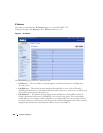
466 Configuring Routing
•
External LSA Checksum
— The sum of the LS checksums of the external LSAs (link state
advertisements) contained in the link-state database. This sum can be used to determine if there has
been a change in a router's link state database, and to compare the link-state databases of two routers.
This value is in hexadecimal.
•
AS_OPAQUE LSA Count
— Shows the number of opaque LSAs with domain wide flooding scope.
•
AS_OPAQUE LSA Checksum
— Shows the sum of the LS checksums of the opaque LSAs with
domain wide flooding scope. This sum can be used to determine if there has been a change in a
router's link state database, and to compare the link-state databases of two routers. This value is in
hexadecimal.
•
New LSAs Originated
— In any given OSPF area, a router originates several LSAs. Each router
originates a router-LSA. If the router is also the Designated Router for any of the area's networks, it
originates network-LSAs for those networks. This value represents the number of LSAs originated by
this router.
•
LSAs Received
— The number of LSAs (link state advertisements) received that were determined to
be new instantiations. This number does not include newer instantiations of self-originated LSAs.
•
External LSDB Limit
— The maximum number of AS-External-LSAs that can be stored in the
database. A value of -1 implies there is no limit on the number that can be saved. The valid range of
values is -1 to 2147483647.
•
Default Metric
— Sets a default for the metric of redistributed routes.This field displays the default
metric if one has already been set or blank if not configured earlier. The valid values are 1 to 16777214.
Enter 0 to unconfigure.
•
Maximum Paths
— Configure the maximum number of paths that OSPF can report to a given
destination. The valid values are 1 to 4.
•
AutoCost Reference Bandwidth
— This field configures the value that OSPF uses in calculating the
default metric for an interface. OSPF calculates the link cost of each interface as Cost = (Reference
Bandwidth in Mbps) / (Interface Bandwidth). For example, setting this value to 1000 Mbps would
cause all 1-Gbps interfaces to have a default cost of 1000/1000 = 1. For 100 Mbps interfaces, the
default cost would be 1000/100 = 10.
•
Default Passive Setting
— Enable this setting to make all interfaces on the switch operate in passive
mode passive. Configuring this field overwrites any present interface level passive mode setting. OSPF
does not form adjacencies on passive interfaces, but it does advertise attached networks as stub
networks. Interfaces are not passive by default. It is common to configure an OSPF interface to be
passive when OSPF must advertise the subnets configured on the interface, but routers on the subnet
belong to other OSPF domains, such as an OSPFv3 router at the end of a 6to4 tunnel.


















